My visit to Rome started with preconceptions. The travel tales of friends, twitter rants about Rome’s tourism problem, and the myopic comments of armchair travellers seeped into my consciousness. Rome must suck, I thought.
Expecting rude natives, endless traffic jams, mediocre food, stinking streets, and queues for everything, I was ever hopeful to avoid the worst of it. Happily, expectations vs reality proved to be 180 degrees out of phase as usual, but for all the right reasons. The truth is that most of the locals were friendly and the traffic was no worse than any other capital city. The food was, well, world-class. Even for a non-fan of pasta and pizza, the alternatives, of which there are many, were more than enough to make up for the traditional stars of Italian cuisine.
Rome’s streets smelled fine. In fact, I detected an aroma of flowers most of the time. Not to mention the people, who smelled just like they dressed: classy. Even the guys wore perfume that had me wondering what I’m doing wrong. Queues – well, there were some, but during a glorious November stretch of the most perfect weather, queues were a minor irritant.
Rome exceeded expectations.
The hype is real, people. Rome has it all. History, food, culture, and weather.

What to see in Rome in 3 days
Here’s a sample itinerary that follows no rules, ticks very few boxes, and ignores the bucket lists of every Rome blog on the internet.
An important point: three days is not enough to see Rome. It’s just scratching the surface. It might be good enough for your Instagram snaps, but Rome deserves more of your time.
A trip to Rome is a voyage into art, history, and food. To see Rome in a day is impossible. Rome in a weekend is barely scratching the surface. Rome in a lifetime is probably more realistic. This city is a densely packed treasure trove of culture and aesthetics. I don’t normally do bucket lists, but when I do…..
Rome is not like any other city. It’s a big museum, a living room that shall be crossed on one’s toes.
Alberto Sordi

The Colosseum
When people tell me about an important attraction or culturally significant part of a city they missed, I respond by saying, “Oh, visiting that city without seeing that attraction is like visiting Rome without seeing the Colosseum”.
But what if you missed the Colosseum? Let’s just say that It’s a must-see. A must-do, if you will.
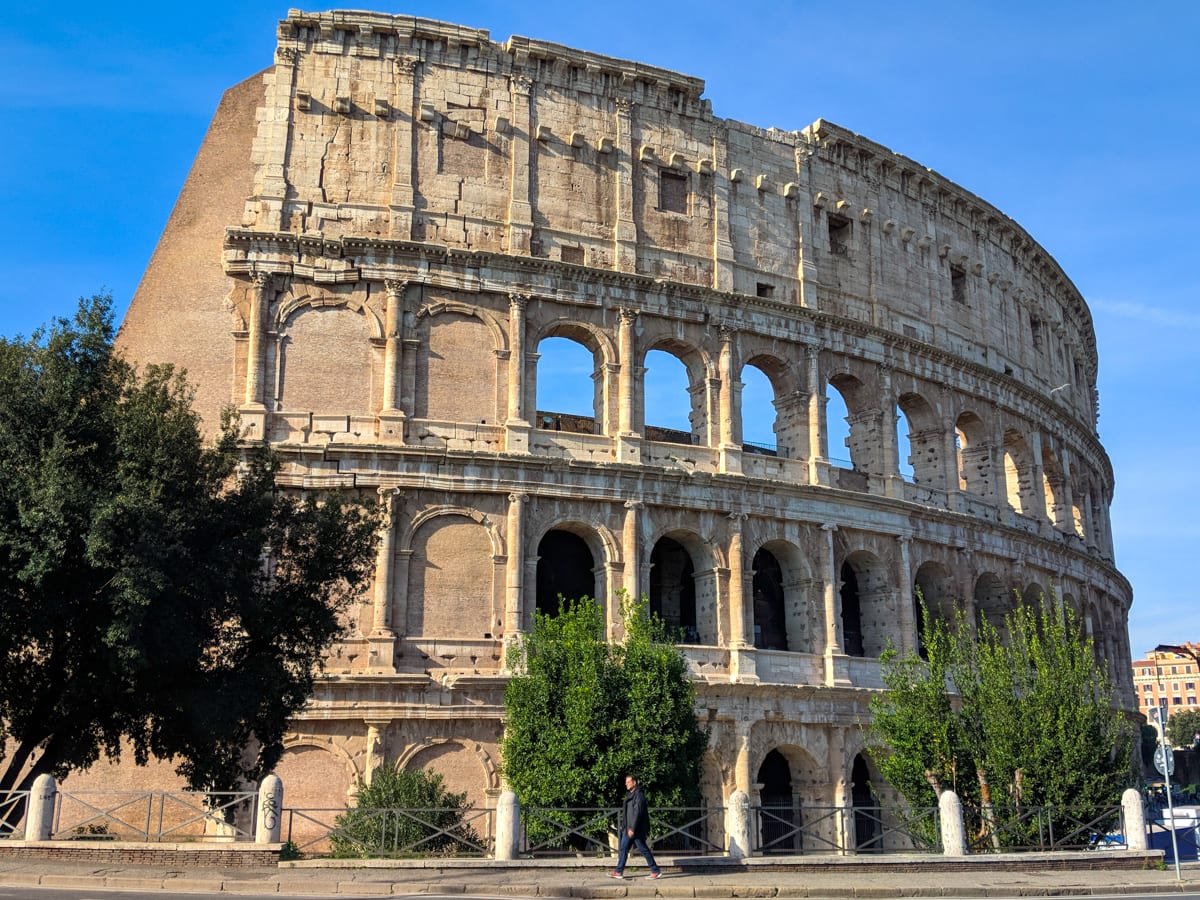
The ancient world’s best known entertainment venue is an icon of Rome, of Italy, and even of Europe. The limestone and concrete masterpiece once held 50,000 people at a time as they watched the (acceptable for the time) blood sports, duels, and general mayhem within the walls. By appealing to the base senses of the Roman public, the Colosseum’s bloody spectactles kept the masses under contro. Sort of like Netflix and Facebook these days.
Stunning from the outside, the building is even more impressive from the inside.
To see Rome in a day is impossible
Vatican City & The Pope’s Residence
Despite my lack of religious convictions, the Vatican registers high on my imaginary list of amazing places. The Vatican’s architecture, grandeur, and opulence are breathtaking. Even more breathtaking than the walk up the 551 steps to the top of the Dome of St Peter’s Basilica.
Fit people: don’t skip the steps! This is how people used to climb up to the Dome. And you’re all about authenticity, right?
Nonetheless, the climb is rewarding, although the passageway gets narrow and a bit claustrophobic near the top.
Not so fit people: Pay the money and take the lift!

At the top, enjoy the spectacular view across Rome and the Vatican City from inside the Dome of St. Peter’s. From this vantage point, the city is possibly even more beautiful than from ground level. From here you’ll get a real sense of the gravity of the religious experience in the centre of the world for the Catholic faith. I do believe it moved me.
On the ground floor of St Peter’s Basilica, many beautiful things vy for your attention. The large 4-post structure over the altar is called St. Peter’s Baldachin. It’s a bronze sculpted canopy, crafted in Baroque style, and marks the spot (allegedly) of St Peter’s Tomb. The Baldachin sits directly under the dome of the basilica.

Right down to the floor tiles and wooden posts, almost everything inside this magnificent building is beautiful and intricate. It’s a photographer’s dream location. You can’t lose. Turn your camera on and just snap away! A little bit of Lightroom and the photos are fit for National Geographic (if only it was that easy)
St. Peter’s Basilica is built upon the tomb of St Peter (Jesus’s right-hand man, in case you didn’t know). And this isn’t the first iteration of the building. The first one was flattened but the Christian Romans built another. This version of the church dates from 1626 after 150 years of reconstruction and the input of Michaelangelo, Raphael, and Donato. The original church (It becomes a Basilica when the pope says so) was built in 319 AD and lasted for 1000 years. It’s true what they say: They don’t make things like they used to.

The Swiss Guard, a band of expertly trained bodyguards and soldiers have two purposes: to protect the pontiff and provide ceremonial duties. With only one assassination attempt on a Pope in the last 40 years, you might think the Swiss Guard has an easy job. Wondering where you can sign up? Fancy donning the Carnaval-style outfit and living in Rome? Not so fast. Only unmarried, army-trained, Swiss Catholic males between 19 and 30 years of age can apply for the job.
The entire Vatican City is a UNESCO World Heritage Site (and why wouldn’t it be?) and is like a sort of religious Disney World. A living museum that warrants a second or third visit.
Inside the Vatican grounds, yet another fountain (Rome is filled with them) marks the entrance to St. Peter’s Square. The impressive Fontana Gemella del Bernini is part of a set. The other fountain, by Carlo Maderno, is older and sits at the north end of the square.
As the sun sets, the fountains come to life as lights under the water illuminate the stone sculptures and flowing water. If you plan on arriving late, know that admission to the Basilica and the Sistine Chapel ends at around 5pm. The ticket office closes at 4pm and the doors shut at 6pm. The entire place closes on Sunday (except for the last Sunday of each month, when entrance is free). Got it?
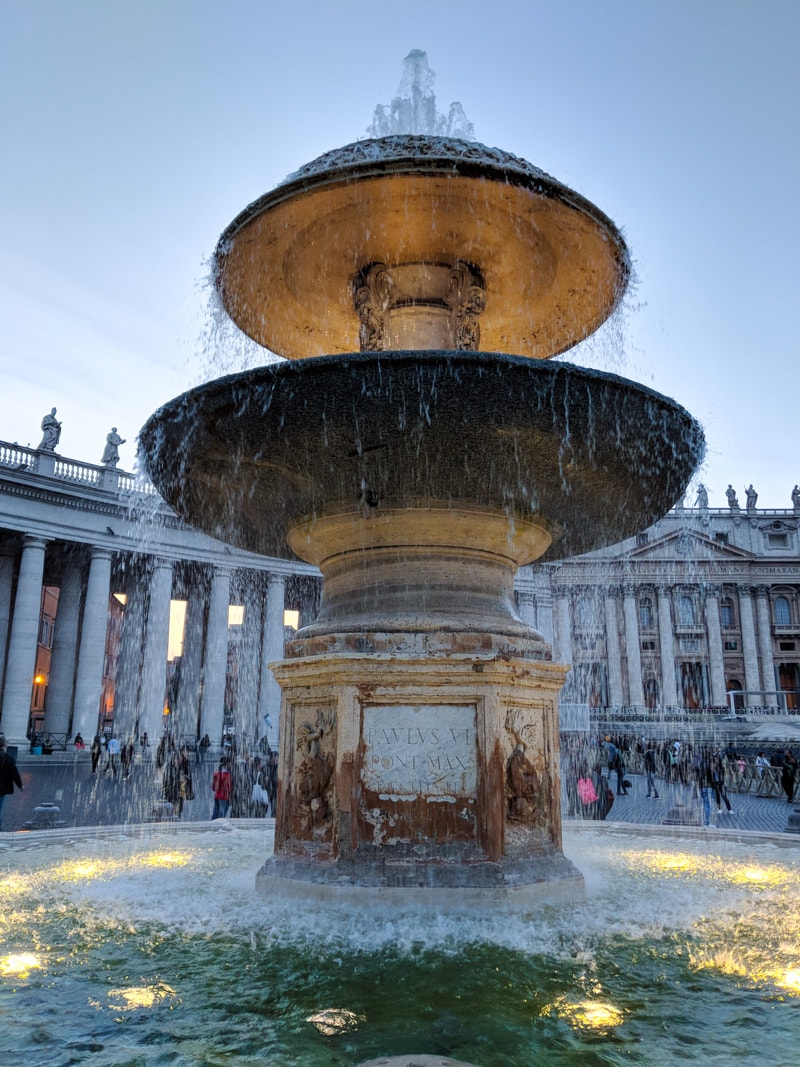
Watch out for tour guides and people that offer to get you past the queues. It’s a scam. If you can walk on your own two feet and you’ve made it to this far, you don’t need any assistance or “special tickets” to enter St Peter’s.
How is it possible to say an unkind or irreverential word of Rome? The city of all time, and of all the world!
Nathaniel Hawthorn
A small merry-go-round along the Lungotevere Castello near the Ponte Umberto I bridge is unnoticeable by day. By night, on the other hand, this tiny amusement ride looks like it Instagram commissioned it.

The Spanish Steps
Like most of the main sights in the city, The Spanish Steps of Rome are photogenic.
At least that’s how they are on rainy, cold winter nights. During the summer, however, the sea of selfie sticks and Insta influencers in ankle-length flowery dresses means you can hope for a glimpse of steps when someone moves position.
But there’s little point grumbling about “other” tourists. The steps have always been popular with visitors. Even before the selfie-sticks, locals and foreigners came to this part of Rome to hang out. It probably looked just like this 100 years ago, minus the hand-held technology.
Be warned, the Italian authorities are fining people for sitting on the steps. But there’s no need. We’re in Rome! Finding a cafe or bar with seats is not a problem.
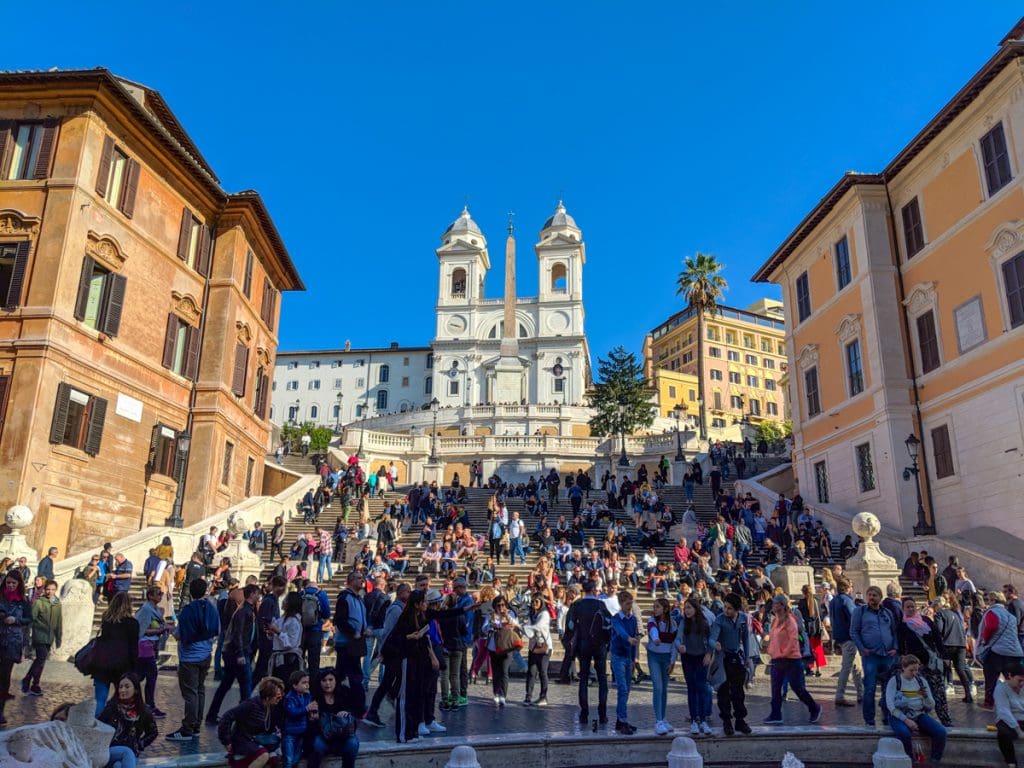
Trevi Fountain
Speaking of tourists, if you want to see the Trevi Fountain like it is on the postcards, visit before 9am or after midnight. Otherwise you can expect chaos. Visiting by night is not only romantic but it’s also peacefeul. It can be like getting front row seats in an empty cinema.
I’m told that a good time to take photos is just before sunrise. My plan for a nocturnal photo shoot was foiled by my sleeping through an alarm. I’ll get those shots the next time.
The Trevi Fountain is beautiful and if you focus on the water and the sculptures and use your imagination, you might sense what it was like to be there a few hundred years ago. Built in 1732, at the end of the end of the Renaissance in Italy, this icon of Rome is probably the most famous fountain in the world.
Basilica Papale di Santa Maria
Rome has more than one major basilica. In fact, there are 4 in the city of Rome (and nowhere else in the world).
The Basilica Papale di Santa Maria Maggiore (Basilica of Saint Mary Major) is another religious building with an even more stunning interior than the impressive exterior.

The church dates from the 5th century and although it has been altered, improved, and restored, the building survived earthquakes and partial demolitions.
Where to find it: Piazza di S. Maria Maggiore, at the end of the Via di S. Maria Maggiore.

Largo di Torre Argentina
You might walk straight past the Largo di Torre Argentina by day. But as night falls, the lights go on and the ruins become quite eye-catching.
This square is allegedly the spot where Roman Emperor Julius Caesar was killed. The public are not permitted to enter the grounds but this will change in 2021 when walkways for visitors will help feed the visiting public’s voracious appetite for more. The word Argentina in the title has nothing to do with the South American country, by the way.

Piazza della Rotonda & Pantheon
Great for people watching from the cafes around the square. In fact, watching the people in cafes watching people in the square is a study in anthropology.
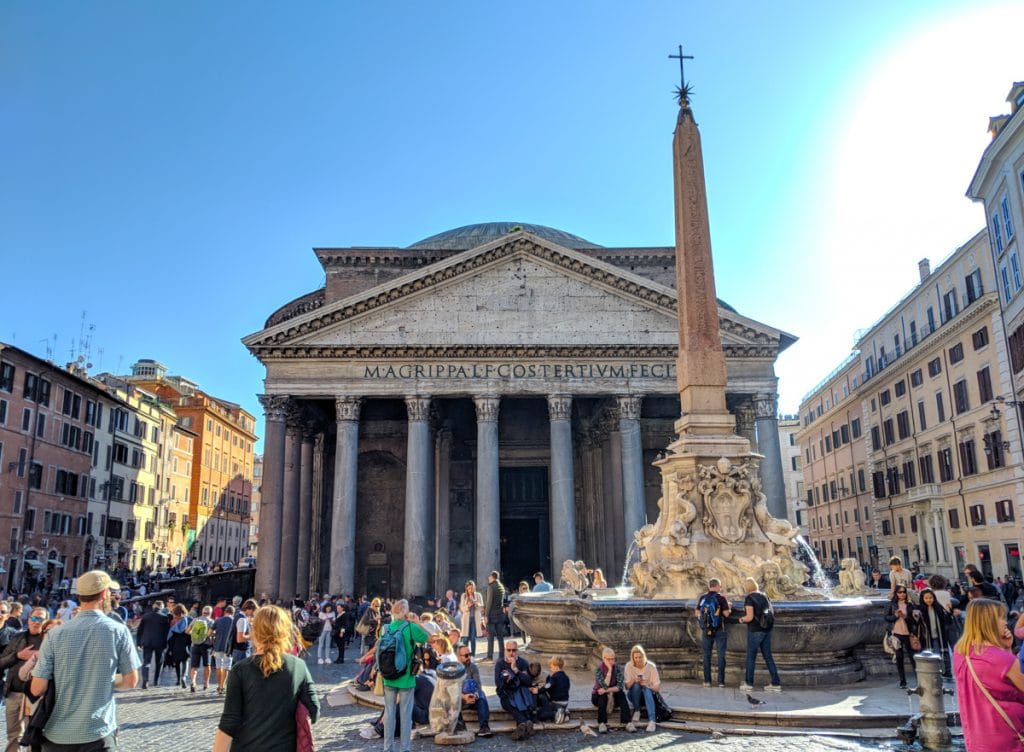
The Pantheon, a two thousand year old church and former Roman temple, appeals to my pattern-loving brain. The geometrical shapes and logical lines in the ceiling are Escher-esque.

Orange Garden
Rome’s Orange Garden (Giardino degli Aranci), real name “Savello Park”, is one of the best places to view the city from above. The garden sits on Aventine Hill, beside the River Tiber and is a popular spot for tourists and locals.
You might be lucky enough to hear classically-trained groups of musicians busking while you watch the sunset over Rome.
A trip to Rome is a voyage into art, history, and food
Near the garden, you’ll find the Ponte Palatino, which bridges the River Tiber. It’s a beautiful spot, as demonstrated by the photo below.

Circus Maximus
On your way up to the Orange Garden, you can’t miss the Circus Maximus. This Roman chariot-racing stadium is impressive even in its current non-functioning state. There hasn’t been a race here for a while but it’s easy to imagine Roman chariots blazing a trail around this huge track to the delight of spectators.
The Rolling Stones played here in 2014 and apparently paid less than $10000 for the location hire. Sounds like a bargain. The producers of the terrible Ben-Hur remake didn’t fare so well. The filmmakers wanted to hire out the Circus Maximus as a set for the new movie. They were denied and had to recreate the location in a studio.
The Colosseum and the Circus Maximus hammer home the fact that Rome, during it’s heyday, was a place of entertainment and pleasure. Roman Emperors were smart enough to know that keeping the ordinary people entertained helped prevent discontent and revolts. The state was rich enough to provide these magnificent buildings and venues.

Giardino di Palazzo Venezia
Palazzo Venezia was the headquarters and office of one Benito Mussolini, the Italian dictator and fascist. An attractive and peaceful garden inside the grounds of the palace building shows the luxury enjoyed by tyrants, while at the same time shows their appreciation for beauty.
Palazzo Venezia held a secret until 2010 when workers discovered Mussolini’s hidden World War 2 bunker under the building.

St Angelo’s Bridge (bridge of angels)
The marble-faced Ponte Sant’Angelo is almost 2000 years old and crosses the River Tiber at a point in the river that gives it a magical feel. St Peter’s Basilica is visible in the distance and the lights of the city at night highlight the beauty of this simple but elegant bridge of five arches.

Eating and Drinking in Rome (Food & Drink Heaven)
Pizza and pasta, the stereotypical Italian dishes, are covered pretty well in this blog.(The pizza is excellent, by the way. I tried a slice and it was, naturally, the best pizza I’ve ever eaten – I just can’t eat much of it)
Ever tried porchetta? I think the Italian translates to “meat lover’s dream”. A boneless rolled roast of pork stuffed with seasoning. Tempted? Well, it gets better. Often stuffed with liver and wild fennel, the roasting process (which can take a day) leaves the crispy skin in the delicately balanced molecular state of perfection between crispy and creamy.
It’s that good.

Tripe, on the other hand, wasn’t. I saw the dish on several menus and, you know, “When in Rome…:.”
Being a meat lover and someone who has eaten pretty much every part of any animal I’ve had the chance to encounter on menus worldwide, I tried it. My only advice is, “when in Rome… leave the tripe to the Romans”. Rubbery cow stomach is a popular main course in Rome. A similar delicacy called “chichulines” in Argentina are a particular favourite of mine. And most of the time, luckily, they arrive cooked. As they should be. My Roman tripe was akin to fake leather car seat (I’d imagine). And surprisingly, smothering innards in in warm Parmesan (Italian extra-hard cheese) doesn’t help the flavour or texture. The waft of pukey dairy (thank the butyric acid for that. Thanks) coupled with the denture-removing sheep’s colon bouncing around my mouth, turned me off weird foods in Italy.
From that point on, I stuck with normal food. You know, like pure pig fat and chicken liver crostini? Yep.
Side note: If you really want to eat freakish food, try the Pig’s blood chocolate pudding or the Maggot Cheese.
Side note on side note: You probably won’t find these items on Pinterest.
Lovers of cured fermented meats, smelly cheeses, olives, all kinds of oils, dried mushrooms, and even delicious fresh-baked breads and wines, will find happiness in the delis of Rome.
Places like the Antica Bottega Di Norcia (below) near the Fountain of Neptune (Fontana del Nettuno) or the L’ Antico Forno Di Fontana Di Trevi near the Fountain of Trevi offer incredibly tasty food, incredibly well presented. Just don’t picnicking on the Spanish Steps.

Ice-cream fans are at risk of accumulating a few extra pounds in Rome thanks to the pervasiveness of gelaterias serving deliciously inexpensive gelatos (Italian ice cream).

Cafes in Rome
If the gelato sends you into a sugar coma, help is at hand in the form of rich and aromatic Italian Coffee, sold almost everywhere. One of the best places to try espresso (the most important brew here) is in La Casa Del Cafe near the Pantheon and the Basilica de Nettuno.
This is also a good spot to get some coffee-related souvenirs or just stock up on the quality stuff.
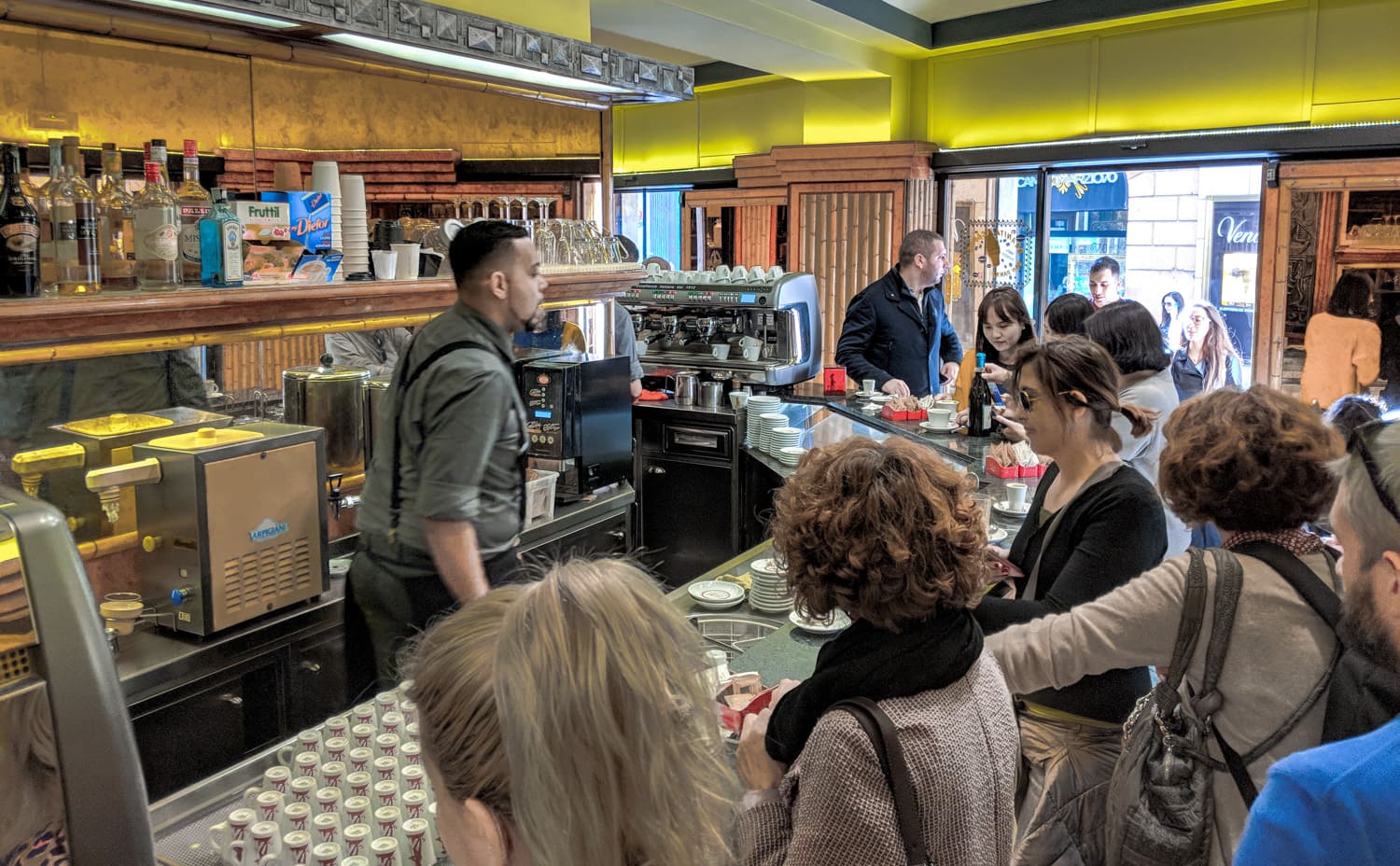
On a sunny day, the Antico Cafè Ruschena is perfect for sipping espresso and eating croissants or any of the cafe’s dangerously sweet pastries and gelatos.
By the way, croissants are called cornetti in Italy, and in fact they are slightly different, being sweeter and softer. A single pastry is a cornetto (yep, like the ice cream brand).

Another super popular (with locals) and ultra-Italian cafe is the Sant’ Eustachio Il Caffè on the Piazza di S. Eustachio. Ordering a coffee here might look like an exercise in ordering chaos, but in true Italian style, personal space and order is ignored but everything works out in the end.
Order whatever coffee the locals are drinking. But you should know that this is no ordinary coffee. Barristas pour water from an ancient aqueduct over your coffee beans. At least that’s a unique selling point the cafe is happy to promote.
Be warned, that a seat outside will cost you a few Euros.
Rome Travel Blogging: Photos of The Eternal City & City of Seven Hills
It’s not hard to take good photos in Rome. Anyone with a decent camera, smartphone, and Lightroom can turn “okay” photos into “oh yeah” photos. But of course, the subject matter is important. Everywhere you look in the city (at least near the city centre) there are incredible photos opportunities. Rome’s street photography scene is second to none.
I used a Google Pixel 2 and Lightroom to produce these images of Rome in the beautiful light of November.
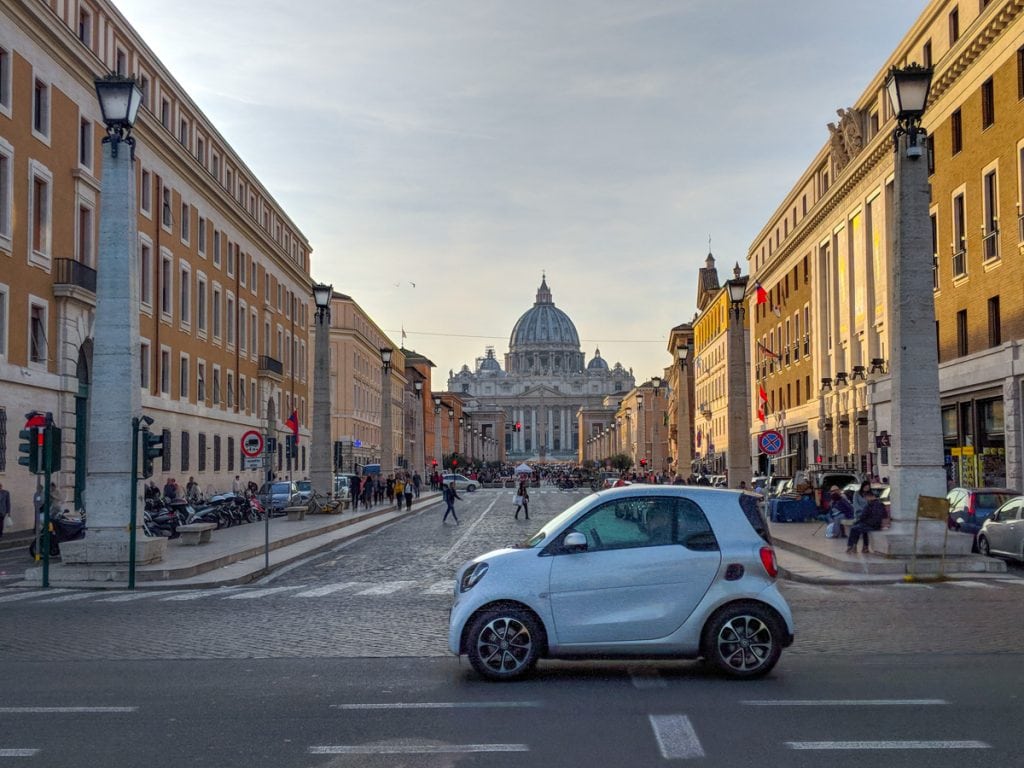
Tips For Travel in Rome
- If you are planning on visiting the city know that many museums are closed on Mondays.
- Rome’s major museums and galleries are free on the first Sunday of each month.
- It’s worth visiting some attractions at night. Many of Rome’s most impressive sights are even better under lights (or moonlight).
- Look out for small fountains (called “nasoni”) dotted around the city. The water is clean and free. Save yourself some money on expensive bottled water.
- Take a late dinner. It’s possible to eat late in the city. Italians don’t eat before 8 pm. So if you want to avoid feeding time at the tourist zoo, wait to dine with the locals around 9 pm or even 10 pm.
- Wear comfy shoes. Those dress shoes and high heels might be good for your photos but they will destroy your feet. Expect to walk a lot in the city. And that leads me to the next question
- Ordering coffees and drinks at the bar of a restaurant or cafe is often cheaper than taking a seat. Sometimes, a seat outside will cost you more than the coffee.
Frequently Asked Questions
When is the best time to visit Rome?
Rome is a city for all seasons but to avoid the crowds, visit in late fall/autumn or early spring.
What is the best way to get around Rome?
By foot. Without a doubt, walking the streets and boulevards is the best way to experience everything about the city.
Is Rome safe to walk at night?
It’s safe to walk at night. Just use common sense, carry a maps app on your phone, and even if your lost don’t ask random people in dark alleys for directions. Always look like you know where you’re going.
How many days do you need in Rome?
If you only want to visit the main sights, take photos and move on, 2-3 days is enough. If you want to go deep, spend time in the museums, sample all the food, and meet the locals, a week is barely enough.
Is there Uber in Rome?
Yes, Uber is available.
How much does a taxi cost from Rome airport to city center?
A taxis ride from the airport will be expensive. Expect to pay around €50. A better option is the train.


